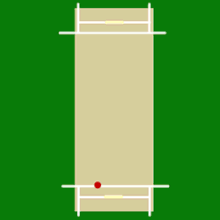Leg spin
This article needs additional citations for verification. (December 2008) |
| Part of a series on |
| Bowling techniques |
|---|

Leg spin is a type of spin bowling in the sport of cricket. A leg spinner bowls right-arm with a wrist spin action, causing the ball to spin from right to left in the cricket pitch, at the point of delivery. When the ball bounces, the spin causes the ball to deviate sharply from right to left, that is, away from the leg side of a right-handed batsman. The same kind of trajectory, which spins from right to left on pitching, when performed by a left-arm bowler is known as left-arm orthodox spin bowling.
As with all spinners, leg spinners bowl the ball far slower (70–90 km/h or 45–55 mph) than fast bowlers. The fastest leg spinners will sometimes top 100 km/h (60 mph). Leg spinners typically use variations of flight by sometimes looping the ball in the air, allowing any cross-breeze and the aerodynamic effects of the spinning ball to cause the ball to dip and drift before bouncing and spinning (usually called "turning") sharply. While very difficult to bowl accurately, good leg spin is considered one of the most threatening types of bowling to bat against, since the flight and sharp turn make the ball's movement extremely hard to read and the turn away from the batsman (assuming he or she is right-handed) is more dangerous than the turn into the batsman generated by an off spinner.
Highly skilled leg spin bowlers are also able to bowl deliveries that behave unexpectedly, including the googly, which turns the opposite way to a normal leg break and the topspinner, which does not turn but dips sharply and bounces higher than other deliveries. A few leg spinners such as Abdul Qadir, Anil Kumble, Shane Warne and Mushtaq Ahmed have also mastered the flipper, a delivery that like a topspinner goes straight on landing, but floats through the air before skidding and keeping low, often dismissing batsmen leg before wicket or bowled. Another variation in the arsenal of some leg spinners is the slider, a leg break pushed out of the hand somewhat faster, so that it does not spin as much, but travels more straight on.
To grip the ball for a leg-spinning delivery, the ball is placed into the palm with the seam parallel to the palm. The first two fingers then spread and grip the ball, and the third and fourth fingers close together and rest against the side of the ball. The first bend of the third finger should grasp the seam. The thumb resting against the side is up to the bowler, but should impart no pressure. When the ball is bowled, the third finger will apply most of the spin. The wrist is cocked as it comes down by the hip, and the wrist moves sharply from right to left as the ball is released, adding more spin. The ball is tossed up to provide flight. The batsman will see the hand with the palm facing towards them when the ball is released.
History
In the 1970s and 1980s it was thought that leg spin would disappear from the game due to the success of West Indian and later Australian teams exclusively using fast bowlers. During this time Abdul Qadir of Pakistan was the highest-profile leg spinner in the world and is sometimes credited with "keeping the art alive".[1][2] However, leg spin has again become popular with cricket fans and a successful part of cricket teams, driven largely by the success of Shane Warne, beginning with his spectacular Ball of the Century to Mike Gatting in 1993.
Notable players
Players listed below have been included as they meet specific criteria which the general cricketing public would recognise as having achieved significant success in the art of leg spin bowling. For example: leading wicket-takers, and inventors of new deliveries.
- Bernard Bosanquet - credited with inventing the googly
- B. S. Chandrasekhar - took 5 wickets in an innings on 16 occasions
- Clarrie Grimmett - 216 Test wickets, world record 1936-53
- Anil Kumble - 619 Test wickets (3rd all-time), BBI* 10/74
- Abdul Qadir - took 10 wickets in a match on 5 occasions
- Shane Warne - 708 Test wickets (2nd all-time), one of five Wisden Cricketers of the Century[3]
Note: * BBI - Best bowling in an innings
References
- ^ Abdul Qadir, player profile Scyld Berry et al., Cricinfo, 1998 and November 2008.
- ^ Farewell to Shane Warne as cricket's great teaser bowls his final ball Mike Selvey, The Guardian, 19 May 2011.
- ^ "Wisden - Five cricketers of the century". Cricinfo.
